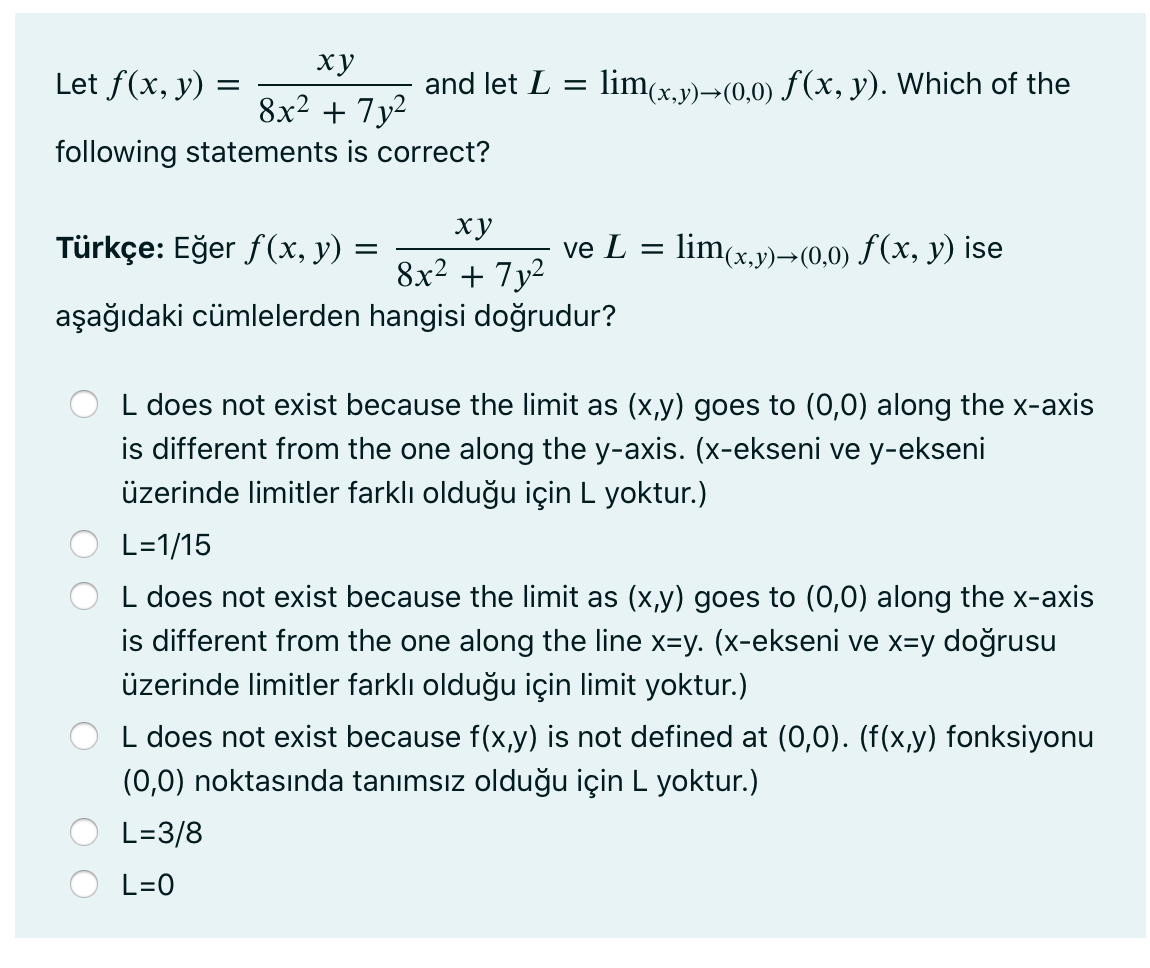ху Let f(x, y) = and let L = lim(x,y)>(0,0) f (x, y). Which of the 8x² + 7y² following statements is correct? ху Türkçe: Eğer f(x, y) = ve L 8x2 + 7y² lim(x.y)¬(0,0) f(x, y) ise aşağıdaki cümlelerden hangisi doğrudur? L does not exist because the limit as (x,y) goes to (0,0) along the x-axis is different from the one along the y-axis. (x-ekseni ve y-ekseni üzerinde limitler farklı olduğu için L yoktur.) L=1/15 L does not exist because the limit as (x,y) goes to (0,0) along the x-axis is different from the one along the line x=y. (x-ekseni ve x=y doğrusu üzerinde limitler farklı olduğu için limit yoktur.) L does not exist because f(x,y) is not defined at (0,0). (f(x,y) fonksiyonu (0,0) noktasında tanımsız olduğu için L yoktur.) L=3/8 L=0
ху Let f(x, y) = and let L = lim(x,y)>(0,0) f (x, y). Which of the 8x² + 7y² following statements is correct? ху Türkçe: Eğer f(x, y) = ve L 8x2 + 7y² lim(x.y)¬(0,0) f(x, y) ise aşağıdaki cümlelerden hangisi doğrudur? L does not exist because the limit as (x,y) goes to (0,0) along the x-axis is different from the one along the y-axis. (x-ekseni ve y-ekseni üzerinde limitler farklı olduğu için L yoktur.) L=1/15 L does not exist because the limit as (x,y) goes to (0,0) along the x-axis is different from the one along the line x=y. (x-ekseni ve x=y doğrusu üzerinde limitler farklı olduğu için limit yoktur.) L does not exist because f(x,y) is not defined at (0,0). (f(x,y) fonksiyonu (0,0) noktasında tanımsız olduğu için L yoktur.) L=3/8 L=0
Chapter3: Functions
Section3.3: Rates Of Change And Behavior Of Graphs
Problem 2SE: If a functionfis increasing on (a,b) and decreasing on (b,c) , then what can be said about the local...
Related questions
Question

Transcribed Image Text:ху
Let f(x, y) =
and let L
lim(x.y)¬(0,0) f(x, y). Which of the
8x² + 7y²
following statements is correct?
ху
Türkçe: Eğer f(x, y) =
ve L =
lim(x.y)→(0,0) f(x, y) ise
8x2 + 7y2
aşağıdaki cümlelerden hangisi doğrudur?
L does not exist because the limit as (x,y) goes to (0,0) along the x-axis
is different from the one along the y-axis. (x-ekseni ve y-ekseni
üzerinde limitler farklı olduğu için L yoktur.)
L=1/15
L does not exist because the limit as (x,y) goes to (0,0) along the x-axis
is different from the one along the line x=y. (x-ekseni ve x=y doğrusu
üzerinde limitler farklı olduğu için limit yoktur.)
L does not exist because f(x,y) is not defined at (0,0). (f(x,y) fonksiyonu
(0,0) noktasında tanımsız olduğu için L yoktur.)
L=3/8
L=0
Expert Solution
This question has been solved!
Explore an expertly crafted, step-by-step solution for a thorough understanding of key concepts.
Step by step
Solved in 2 steps with 2 images

Knowledge Booster
Learn more about
Need a deep-dive on the concept behind this application? Look no further. Learn more about this topic, calculus and related others by exploring similar questions and additional content below.Recommended textbooks for you

